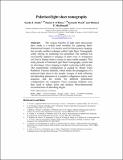Files in this item
Polarised light sheet tomography
Item metadata
| dc.contributor.author | Reidt, Sascha | |
| dc.contributor.author | O'Brien, Daniel | |
| dc.contributor.author | Wood, Kenneth | |
| dc.contributor.author | MacDonald, Michael | |
| dc.date.accessioned | 2016-06-17T09:30:09Z | |
| dc.date.available | 2016-06-17T09:30:09Z | |
| dc.date.issued | 2016-05-13 | |
| dc.identifier | 242396571 | |
| dc.identifier | aaebf3fc-d607-4677-8805-11a20ab07ff2 | |
| dc.identifier | 84971330996 | |
| dc.identifier | 000376380700126 | |
| dc.identifier.citation | Reidt , S , O'Brien , D , Wood , K & MacDonald , M 2016 , ' Polarised light sheet tomography ' , Optics Express , vol. 24 , no. 10 , pp. 11239-11249 . https://doi.org/10.1364/OE.24.011239 | en |
| dc.identifier.issn | 1094-4087 | |
| dc.identifier.uri | https://hdl.handle.net/10023/9004 | |
| dc.description | The research leading to these results has received funding from the People Programme (Marie Curie Actions) of the European’s Seventh Framework Programme (FP7/2007-2013) under REA grant agreement no. 608133 and Scottish Funding Council (SFC) Horizon fund. | en |
| dc.description.abstract | The various benefits of light sheet microscopy have made it a widely used modality for capturing three- dimensional images. It is mostly used for fluorescence imaging, but recently another technique called Light Sheet Tomography solely relying on scattering was presented. The method was successfully applied to imaging of plant roots in transparent soil, but is limited when it comes to more turbid samples. This study presents a Polarised Light Sheet Tomography system and its advantages when imaging in highly scattering turbid media. The experimental configuration is guided by Monte Carlo Radiation Transfer methods, which model the propagation of a polarised light sheet in the sample. Images of both reflecting and absorbing phantoms in a complex collagenous matrix were acquired, and the results for different polarisation configurations are compared. Focus scanning methods were then used to reduce noise and produce three-dimensional reconstructions of absorbing targets. | |
| dc.format.extent | 11 | |
| dc.format.extent | 15313985 | |
| dc.language.iso | eng | |
| dc.relation.ispartof | Optics Express | en |
| dc.subject | QC Physics | en |
| dc.subject | NDAS | en |
| dc.subject.lcc | QC | en |
| dc.title | Polarised light sheet tomography | en |
| dc.type | Journal article | en |
| dc.contributor.institution | University of St Andrews. School of Physics and Astronomy | en |
| dc.identifier.doi | https://doi.org/10.1364/OE.24.011239 | |
| dc.description.status | Peer reviewed | en |
This item appears in the following Collection(s)
Items in the St Andrews Research Repository are protected by copyright, with all rights reserved, unless otherwise indicated.

